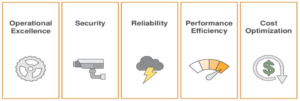
What Is The AWS Well-Architected Framework?
The AWS Well-Architected Framework is a set of best practices designed to help organizations build secure, high-performing, resilient, and efficient cloud infrastructures on AWS. These guidelines enable cloud architects to create solutions that align with business goals while maintaining optimal cost and performance.The Framework consists of five key pillars that guide the design and operation of workloads in the AWS Cloud.
Well-Architected Framework Pillars

1. Operational Excellence
Operational excellence focus on efficient and reliable cloud operations. Key practices include:
-
- Eliminating resource duplication.
-
- Configuring servers with elastic resources to handle variable workloads.
-
- Implementing auto-scaling to match resource demand.
-
- Continuously enhancing operations and conducting game days to test workload resilience.
-
- Planning for disaster recovery (DR) scenarios, including failover mechanisms.
Example: AWS services like AWS Config help monitor configuration compliance, while AWS Step Functions enable orchestration of workflows to automate operational processes. For instance, you can use AWS Config to detect non-compliant configurations and trigger remediation actions through Step Functions, ensuring a seamless and efficient operational environment without manual oversight.
2. Security
This pillar focuses on safeguarding data, systems, and assets by leveraging AWS’s security capabilities. Best practices include:
-
- Applying security at every layer of the cloud, such as configuring VPCs, subnets, and network access controls (NACLs).
-
- Granting users the least privileges necessary to perform their tasks.
-
- Implementing robust audit and traceability practices, including centralized identity management and avoiding static credentials.
Example: AWS services such as Amazon Cognito can help manage user authentication and authorization securely, while AWS CloudHSM provides hardware-based key storage for encryption. You can also use AWS Identity and Access Management (IAM) to manage access control policies, ensuring that only authorized users and services have the appropriate permissions, and AWS Shield to protect your applications from DDoS attacks, ensuring your infrastructure remains robust and compliant.
3. Reliability
Ensuring that workloads operate reliably and consistently is crucial. Reliability involves:
-
- Designing workloads to automatically recover from component failures.
-
- Scaling resources horizontally or vertically based on demand.
-
- Managing infrastructure changes through automation rather than manual processes.
Example: Services like Amazon Elastic Load Balancing (ELB) can automatically distribute incoming traffic across multiple targets to prevent downtime during failures Additionally, Auto Scaling dynamically adjusts the number of instances running based on traffic, ensuring your application can handle varying loads.Using Amazon Aurora with cross-region replication also allows for seamless failover to a secondary region in the event of a regional disruption, ensuring high availability and resilience.
4. Performance Efficiency
Performance efficiency is about using resources in a way that meets system requirements without waste. This includes:
-
- Leveraging global resources to reduce latency and enhance user experience.
-
- Utilizing serverless architectures where possible to enable dynamic scaling and reduce manual provisioning.
Example: services like Amazon EC2 Auto Scaling adjust compute resources in real time based on traffic, while Amazon CloudWatch provides detailed performance metrics to monitor and adjust resources accordingly. Additionally, using AWS Fargate allows you to run containerized applications without managing servers, automatically scaling to meet demand while ensuring efficient resource utilization, all without the need to over-provision infrastructure.
5. Cost Optimization
The cost optimization pillar ensures workloads are cost-effective. Key actions include:
-
- Measuring the efficiency of cloud resources.
-
- Avoiding unnecessary resource usage.
-
- Following AWS cost optimization guidelines and tracking budgets effectively.
Example: AWS Cost Explorer helps track and analyze your spending trends, while using Amazon EC2 Spot Instances can significantly reduce costs for non-critical workloads. Additionally, by utilizing S3 Lifecycle Policies, you can automatically transition data to more affordable storage classes like S3 Glacier, ensuring cost reductions without impacting access to the data.
Why Get A Well-Architected Review?
Migrating to AWS can improve operational efficiency and reduce costs, but to maximize these benefits, organizations need to ensure their cloud architecture adheres to the Well-Architected Framework.
A Well-Architected Review assesses your workloads against these best practices and provides actionable recommendations to optimize your cloud environment.
Schedule a Well-Architected Review with Devops TechLab
AWS Advanced Consulting Partners, such as Devops TechLab, offer Well-Architected Reviews. These reviews involve:
-
- Assessing client workloads against the Framework.
- 2.Providing tailored recommendations for improvement.
- 3.Offering hands-on optimization services to align infrastructure with best practices.
By leveraging the Well-Architected Framework, organizations can unlock the full potential of the AWS cloud, ensuring secure, reliable, and cost-efficient operations.


